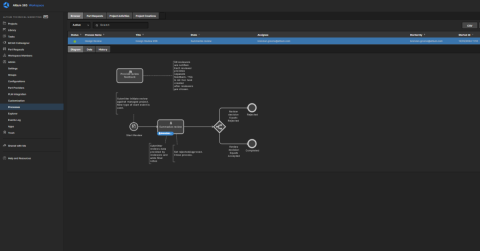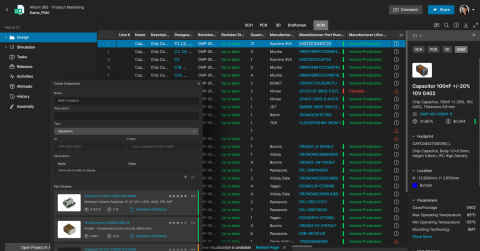Accelerate Last-Minute Design Changes with Altium 365

Are you curious about how to solve your production blockers before they derail your product launch or, even worse, stop your production line? Join us as we explore how Altium 365® can help you swiftly manage last-minute design changes, enclosure fits, and requirements. Read on and eliminate errors, wasted time, and fragmented workflows.
A Late-Stage Change: Real-Life Scenarios
In our previous article, we’ve discussed the most common production blockers. Now, let’s explore how these challenges can affect operational efficiency in practice by analyzing two scenarios where a late-stage change causes a domino effect of issues across engineering, procurement, and manufacturing, threatening production timelines and product integrity.
Imagine the first situation. Electrical engineers introduce a new product but grapple with outdated components and lack the means to capitalize on previously validated designs. They use the first component they can find, which meets their needs but leads to increased risks.
In the second scenario, the procurement is misled during production by incorrect lead times for critical parts. No alternative parts were identified earlier, so quick action is required to address non-manufacturable boards and critical quality concerns.
In both cases, there’s a huge pressure on teams to handle parts and design changes urgently, but they meet the following obstacles:
- Mechanical engineers face time-consuming file exchanges to ensure the board fits the enclosure, risking data loss and miscommunication with each manual export/import cycle. The manual tracking of components and updates consumes up to 40 hours per engineer.
- Project managers work to keep the timeline intact but often lack the visibility to do so effectively.
- The engineering manager, striving for efficiency, is bogged down by slow knowledge transfer and lengthy review cycles.
- Critical stakeholders are not connected to the process at this stage.
- Product managers and system architects struggle to align the final product with original requirements and market demands.
- Manufacturers receive information too late, which results in costly production line pauses and rework.
How do we mitigate these issues? Through a unified digital infrastructure that enables real-time collaboration, contextual information flow, and proactive change management to maintain momentum and ensure product success. One of the solutions you might use is Altium 365, the agile electronics development platform that brings together all aspects of electronics development, helping organizations deliver better products faster than ever before.
Agile Component Changes at Development Milestones
Being a modular cloud solution, Altium 365 fosters cross-functional collaboration:
- Procurement and electrical engineering teams work together smoothly, using integrated BOM features for quick decision-making and part replacements, avoiding project delays.
- The librarian quickly aligns replacement components with design needs, using integrated tools for effective component management and collaboration.
- Alternate parts are pre-defined, offering immediate options for substitution, streamlining the process, and avoiding unexpected availability issues.
- Electrical engineers update PCBs efficiently, with shared libraries facilitating one-click updates and 'where-used' insights for broader design impact.
- The ECAD and MCAD CoDesigner collaboration enable rapid adjustments and perfect enclosure fit, minimizing iteration time and errors.
- Changes across MCAD and ECAD are synchronized, ensuring all design rationale is tracked and controlled.
- Release packages are standardized, simplifying the transition to manufacturing.
- The Altium 365 Assembly Assistant app aids in testing circuit updates in up to half the time, fostering readiness for manufacturing.
- The Manufacturer Portal bridges the gap between design and production, facilitating a collaborative manufacturing approach.
Altium 365: Solution Demonstration Step-by-Step
Let's use a practical example and see how Altium 365 can help you deal with obsolete components in your design step by step.
The 'Used Part Report' functionality allows you to quickly identify components in your design that are nearing or have reached the end of their lifecycle. For instance, you might find a component marked as 'discontinued' with additional details provided by the SiliconExpert integration, indicating its remaining lifespan.

You can then look at the BOM and enter the Altium 365 BOM Portal to gain comprehensive visibility of all components in your design. This hub offers various views, including the status of components and other detailed data, combining data and insights from SiliconExpert and Octopart.
When you encounter an obsolete component, the BOM Portal helps you explore alternatives. For example, you can view the datasheet provided by Octopart, which might indicate the component's discontinuation and direct you to the manufacturer's website for more information. Here, you might find a suitable replacement product.
After selecting a potential replacement, you can analyze its details and compatibility with your design. Altium 365 speeds up this process, allowing you to create an alternate for the obsolete component directly in the BOM Portal. This involves selecting the alternate part and comparing different options based on your specified parameters. Once you've chosen an alternative piece, you can easily integrate it into your design.

You can also add comments and track the status of this task.

Additionally, you can initiate a part request directly from the platform, filling in necessary details like datasheets and part numbers. This request is then logged under tasks, where you can track its progress and approval.
Once you've selected and defined the necessary components, you can review your design in the web user interface. Here, you'll find a well-organized display of comments and tasks (enhancing collaboration and communication within your team) and the Altium 365 Requirements and Systems Portal.
In our example, let's say a requirement is defined, such as a connector needing a minimum of 50 pins. Once you agree with the requirement, it can be verified within the system and synced.

Next, an electrical engineer must make corresponding changes in Altium Designer. Suppose your procurement team or librarian marked a component as obsolete and it’s no longer suitable for use. In that case, you can set the component lifecycle in your shared library as obsolete. This action prevents the release of designs with designated component lifecyles, a crucial step in maintaining design integrity.
You can then browse the suggested alternatives matching your design's requirements. Once you've selected a replacement component, you can update your design with the new item, ensuring all part choices and parameters are standardized.
The platform also allows you to use your BOM to update your design in real-time. You can open ActiveBOM and apply the requested changes or submit part requests directly from the interface if needed. After updating your components, you can apply these changes to your PCB design.
Once you've ensured all connections and traces are correct, you can save your work and push the design to the mechanical team, noting the updates made. The important thing here is to document the reasons for your decisions. Altium 365 enables traceability for every decision, providing a clear rationale for each design choice. This transparency is essential for effective collaboration and maintaining high standards in your design process.
If your Altium 365 team still needs to include a mechanical engineer, you can use an email address to invite them to your Workspace with the ME role. The Altium 365 MCAD CoDesigner is compatible with various MCAD tools, including PTC Creo, SolidWorks, Siemens NX, and Autodesk Fusion 360. This compatibility ensures mechanical engineers can work with their preferred tools while staying in sync with the electrical design team.
When a change is made in the design, the CoDesigner system automatically notifies you, eliminating the need for manual checks. It provides previews, giving you immediate insight into the modification. You can always approve or reject the suggested changes. If a change doesn't meet your requirements, you can provide additional feedback, ensuring clear and efficient communication between teams.
MCAD CoDesigner also allows you to integrate mechanical constraints directly into the design process. You can set constraints between component bodies and the board or enclosure to make sure all physical aspects of the design are considered.
In the Manufacturing Portal, you can view all release files in one place and compare them, including the Gerber, the PCB, and the schematic. You may also attach any relevant simulations. From here, you can download your files or send them directly to the manufacturer.

In Altium 365 Assembly Assistant, you can move forward with your manual board assembly. It allows you to methodically go through different parts of your design, placing each component individually.
Learn More
Altium 365 helps teams manage last-minute component changes, maintain design integrity, and facilitate smooth transitions to manufacturing. This combination addresses the immediate challenges of late-stage design changes, providing a foundation for cross-functional collaboration and future advancements in manufacturing, quality control, and other product design domains. To learn more, watch our webinar about overcoming production blockers.











